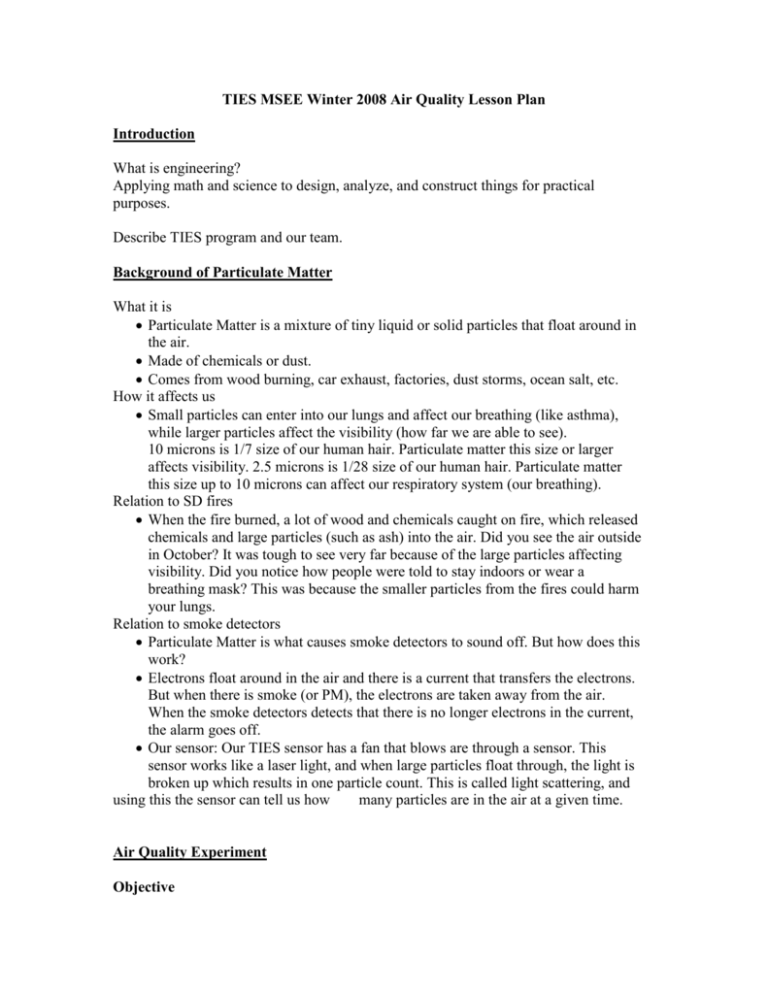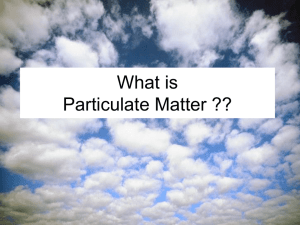Introduction
advertisement

TIES MSEE Winter 2008 Air Quality Lesson Plan Introduction What is engineering? Applying math and science to design, analyze, and construct things for practical purposes. Describe TIES program and our team. Background of Particulate Matter What it is Particulate Matter is a mixture of tiny liquid or solid particles that float around in the air. Made of chemicals or dust. Comes from wood burning, car exhaust, factories, dust storms, ocean salt, etc. How it affects us Small particles can enter into our lungs and affect our breathing (like asthma), while larger particles affect the visibility (how far we are able to see). 10 microns is 1/7 size of our human hair. Particulate matter this size or larger affects visibility. 2.5 microns is 1/28 size of our human hair. Particulate matter this size up to 10 microns can affect our respiratory system (our breathing). Relation to SD fires When the fire burned, a lot of wood and chemicals caught on fire, which released chemicals and large particles (such as ash) into the air. Did you see the air outside in October? It was tough to see very far because of the large particles affecting visibility. Did you notice how people were told to stay indoors or wear a breathing mask? This was because the smaller particles from the fires could harm your lungs. Relation to smoke detectors Particulate Matter is what causes smoke detectors to sound off. But how does this work? Electrons float around in the air and there is a current that transfers the electrons. But when there is smoke (or PM), the electrons are taken away from the air. When the smoke detectors detects that there is no longer electrons in the current, the alarm goes off. Our sensor: Our TIES sensor has a fan that blows are through a sensor. This sensor works like a laser light, and when large particles float through, the light is broken up which results in one particle count. This is called light scattering, and using this the sensor can tell us how many particles are in the air at a given time. Air Quality Experiment Objective In this experiment you will test the quality of air by measuring the number of air particles from different locations. Introduction (Have students volunteer to read) The air we breathe has a lot do do with our health. As we breathe in fresh air, our lungs absorb oxygen from the air and pass it into our blood stream so it can be transported throughout our bodies. Oxygen is important for our whole body to have the energy it needs to survive. It is important for all of us to have clean air to breath. People living in industrial areas are more likely to develop asthma. People who smoke are more likely to suffer from lung cancer. You may have seen an example of the lungs from a smoker which are small, black and unhealthy looking. Years and years of breathing particles of tar and smoke can cause the lung tissue to develop cancer, and can even cause death. Breathing clean air is important for keeping your lungs nice and healthy. Tiny particles of dust and soot in the air can enter your lungs when you breathe, and can block the movement of oxygen. Harmful particles can come from pollutants in the air like dust, smog, soot, smoke, and other chemicals. Because of the importance of clean air to our health, most cities keep track of air pollution by issuing smog warnings on days when there is a high level of air pollution. How clean is the air where you live? What about around your school, where you play at the park, or where your parents go to work? Is the air at a park cleaner than air near a busy intersection? You can do a simple experiment with Vaseline to find out the answers to these questions. Terms, Concepts and Questions You should understand the following terms and concepts: air quality smog particles lungs asthma Materials and Equipment Vaseline string black permanent marker poster board hole punch magnifying lens Experimental Procedure (Students form groups of 5 or 6 to perform the experiment) 1. Cut the poster board into square pieces approximately 3 inches long and 3 inches wide. You should make a total of 12 squares. 2. Using the hole punch, punch a hole in one corner of each square. 3. Tie a piece of string through the hole to make a loop for hanging the square up, on a tree branch for example. 4. Make a data sheet to record where you place your squares, and what data you later will collect from them: Location: Square 1 Square 2 Square 3 TOTAL Average 5. Decide on your five locations. Good locations are: inside your classroom, by the bus stop, on the playground, etc. 6. Write the name of each location in your data table. 7. Using your black permanent marker, draw a 1 inch by 1 inch box in the center of each square. 8. Write the name of the location on the bottom of each square. 9. At each location, find a place to hang up three of your collection squares. You can hang the squares from a tree branch, sign post, light post, or any other safe landmark. 10. Before you hang each square up, spread a thin layer of vaseline in the black box in the center of each square with your finger (or popsicle stick). Hang up the collection square. 11. Leave your collection squares for a couple days. 12. After you have waited, it is time to collect your data from the squares. 13. Revisit each location to retrieve your squares. Remove the squares one at a time. 14. Proceed to the next square and/or location until you have collected all of your squares. 15. Return to your classroom with your squares. Use your magnifying glass to count the number of visible particles you see stuck in the Vaseline inside the boxed area. Write the number in your data table. 16. Now you are ready to make a graph of your data. Make a bar graph by writing a scale for the number of particles on the left side (y-axis) and then by drawing a bar up to the correct number of particles for each location. Remember to label each bar of your graph, or make a color key. 17. Which sites had the most particulate matter in the air? Is this what you expected? What do you think this tells you about the relative air quality at each location?








